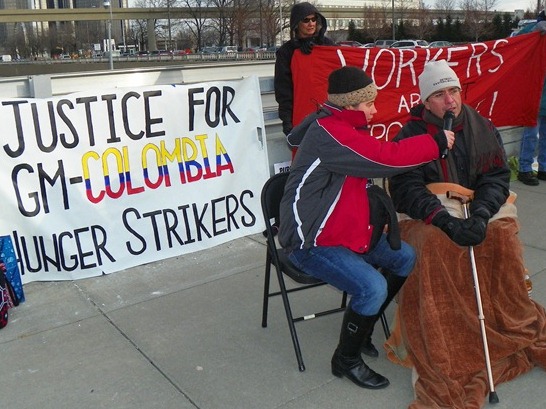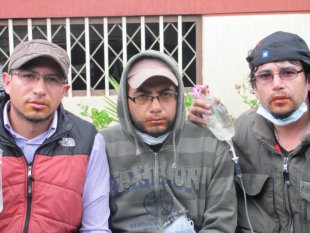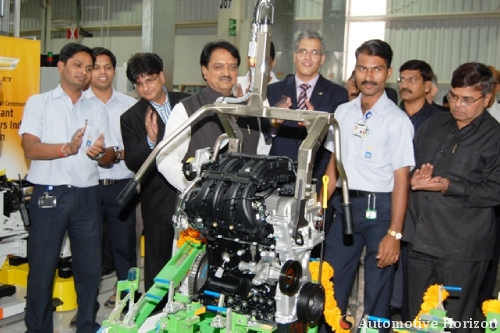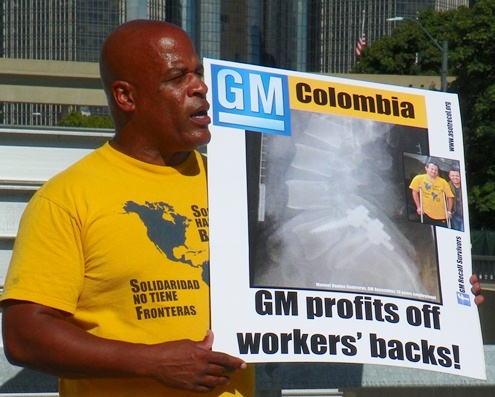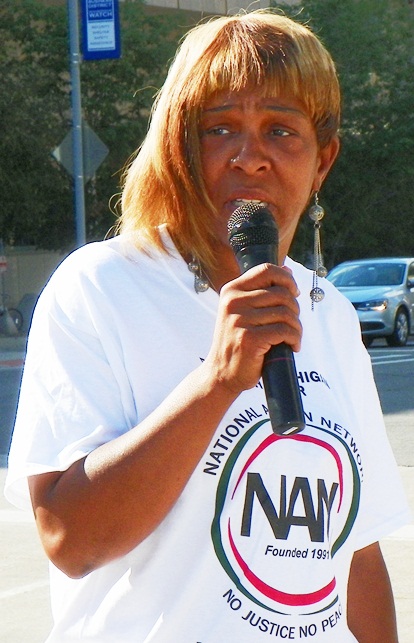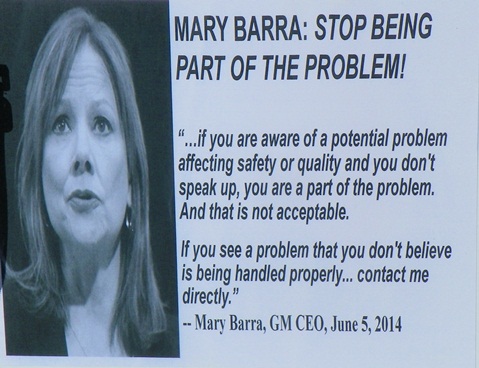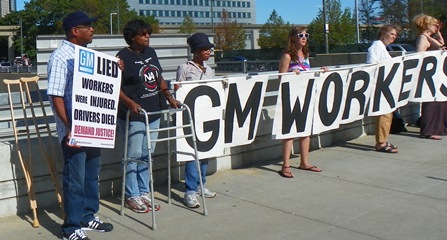By Diane Bukowski
Sept. 15, 2014
DETROIT – Workers brandishing crutches marched outside Cobo Hall as General Motors (GM) Executive Mary Barra spoke to the “World Congress on Intelligent Transportation” here Sept. 7.
“Hey, Mary Barra, we stand with Jorge Parra,” they chanted, referring to a disabled GM worker in Colombia who was fired after being injured on the job and is now conducting a hunger strike that may end in his death.
It is GM’s policy not only in Colombia, but in plants in the U.S. as well to “dump workers like trash,” speakers said.
As workers at GM’s Colmotores Plant conducted a hunger strike outside the U.S. embassy with their mouths sewn shut in 2012, Parra told Alternet, “This is for all the workers. “We are now prepared to die because this situation is critical. General Motors has given us no choice.”
Alternet reported at the time, “More than 200 Colmotores employees have been injured while working at the automotive plant outside Colombia’s capital city of Bogota. Herniated discs, severe carpal tunnel syndrome, lumbar scoliosis and chronic tendonitis are among the list of complaints they claim many have suffered after years spent doing repetitive, physical work making GM’s car parts.Instead of providing medical care and changing the work patterns of injured employees, GM fires them, according to the protesters, who last year set up the Association of Injured Workers and Ex-Workers of Colmotores (Asotrecol) in an attempt to defend their rights.”
Now, according to protest organizer Frank Hammer, GM has carried the same policies over to its plant in Gujurat, India, which Barra recently visited. Hammer said 269 cases of spinal injuries have been documented there, with GM firing those unable to work. GM laid off 800 of 1600 workers and replaced with temporaries, paying the permanent workers 90 cents an hour while the temporaries make 47 cents an hour “for exactly the same work,” Hammer added.
He noted that newspapers in India are now reporting on the Colombian workers’ hunger strike as well.
The Hindu Business Line reported in January, 2014, “Two days after Chief Minister Narendra Modi’s claim about ‘no labour problem in Gujarat’, a workers’ unrest has surfaced at General Motor’s Halol plant near Vadodara where around 450 contractual workers began staging dharna (sit-in) outside the factory premises since Friday, opposing auto maker’s move of giving fresh appointment letters to only a few selected workers.
Out of the nearly 700 contractual workers at GM’s Halol unit, around 450 workers have stopped work since Friday and are sitting outside the factory premises staging protest, a worker union leader said. GM makes Tavera SUV at its Halol plant.”
The newspaper reported other ongoing labor unrest at GM plants in India. GM workers also conducted a mass strike in India in 2011.
“One company, one workforce,” shouted Melvin Thompson, a GM worker from UAW Local 140, as he strode back and forth with a bullhorn. He has visited Parra and the Colombian workers multiple times.
“We’re all related, Colombia and India halfway around the world,” Thompson said. “We love each other. Jorge and his comrades are on a hunger strike again, and this time he says he’s not going to stop. I’m not comfortable with that because I know his commitment, but GM around the world is readily able to pay workers a wage that spends the same in their country as it does here.”
The Colombian workers make only $350 a month.
Thompson noted that in 1994, GM had twice as many workers and their cars cost half as much as they do now.
“But after bankruptcy, these companies are ruthless,” Thompson explained. “They are building a plan for all working people to be subservient, a plan that has room only for the elite and the servant class.”
Notably, Detroit Emergency Manager Kevyn Orr, who is new engineering a phony bankruptcy for the City of Detroit, was on the team of Jones Day lawyers who engineered GM’s Chrysler bankruptcy.
Simone, a Detroit-area Chrysler worker who sustained injuries to her neck and back on the job, recounted her experience with GM’s policies toward its workforce.
“The company only accepted partial responsibility and forced me back to work,” she said. “When you have to walk in pain, it’s very difficult, nobody really understands. We need GM to take responsibility for serious injuries and serious health and safety issues in its plants everywhere.”
The protesters picked up a chant of, “Unsafe plants, unsafe switches, GM bosses count the riches.”
Despite $1.3 billion in costs from an ongoing recall of seven million GM vehicles with faulty ignition switches, GM reported net revenue of $37.4 billion in the first quarter of 2014, compared to $36.9 billion in the first quarter of 2013.
“The performance of our core operations was very strong this quarter, reflecting the positive response of customers to the new vehicles we are bringing to market,” Barra told MLive in April. “Our focus remains on creating the world’s best vehicles with the highest levels of safety, quality and customer service, while aggressively addressing our business opportunities and challenges globally.”
Protester Linda Street disagreed. She reported that she suffered permanent injuries from a car crash due to a faulty ignition switch in her GM car. She said that she once worked three jobs at a time, taking nice trips during her vacations, but now is permanently disabled.
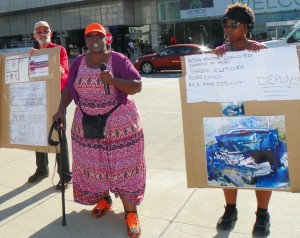
- Injured driver Linda Street speaks as Frank Hammer (l) and friend (r) hold signs displaying results of her accident.
“In 2007, I was driving my car onto the freeway and had to slam on the brakes to avoid another car,” Street told VOD. “The ignition cut off completely, I could not restart the car, and the airbags did not deploy.”
She said vertebrae in her spine, her rotator cuff and her knees were severely injured when the airbags did not work. She has to walk briefly with crutches, or utilize a wheelchair.
So far, 19 people killed in such accidents have been awarded $1 million each by GM, and 125 more have submitted applications for compensation for fatal accidents, the Wall Street Journal and other news sources just reported. Over 300 more individuals have applied for compensation for serious injuries, according to reports from GM.
The switches were installed in Chevrolet Cobalts, Saturn Ions, Pontiac G5s, Chevrolet HHRs, Pontiac Solstices and Saturn Skys, from model years 2003-07, and some others. GM has recalled up to 2.6 million cars with the switches. When a car is jostled, the ignition switches can turn off the engine, cutting power to its brakes, steering and airbags.
Barra was the headline speaker for the 2014 World Congress on Intelligent Transport Systems, which ran from Sept. 7-11 in Cobo Hall, sponsored by the Intelligent Transportation Society of America (ITS America) in partnership with ERTICO (Europe’s ITS) and ITS Asia-Pacific. The World Congress comes to North America every third year.
Other speakers included Gov. Rick Snyder, Detroit Mayor Mike Duggan and Michigan Department of Transportation director Kirk T. Steudle.
ITS America reported that “more than 10,000 of the world’s leading transportation policymakers, researchers, high-tech innovators, and business professionals from the United States, Europe and Asia will gather to share the latest intelligent transportation systems (ITS) applications from around the globe.”
Jim Barbaresso, 2014 ITS World Congress chairman, told attendees in a letter, “We are on the cusp of a transformation, where technology offers realistic solutions to our global mobility, safety, and environmental challenges. Detroit is at the heart of this transformation. The Motor City is made of both grit and silicon, where industry and technology are coming together to forge the next generation of transportation systems.”
But the Congress caused a great deal of mobility problems for metro Detroit drivers.
Not only did it take over Cobo Hall, it also took over at least three quarters of Belle Isle, including all of its interior, for exhibits including vehicle road demonstrations, during all four days of the Congress.

- Protesters outside EM Kevyn Orr’s June 10, 2013 talk at Wayne State. Most Black folks have been driven from the island by the State Police. On Sept. 14, the island was taken over by hundreds of whites in bicycle, car, boat and foot races. Regular auto traffic was consigned to one lane.
Public traffic was relegated to one exterior roadway from the bridge eastbound to the Nature Center on the north end of the island, and back the same way.
Belle Isle is now operated by the State of Michigan, under a $0 “lease” imposed by EM Orr. Apparently the state takeover includes a corporate takeover of the island as well.
This reporter, attempting to ride her bike on the island, heard many people telling guards they wanted to take their children to the Aquarium, the Conservatory, and other attractions which were not accessible. No public notice of the shutdown was given.
ITS America hired a private security agency whose employees, mostly young Black men, had to fend off hostile reactions to the shutdown, without signs or literature to explain what was going on. One worker, who said he was on the verge of leaving due to abuse from motorists, reported that they were not even making minimum wage. Apparently ITS has adopted GM’s policies as well.
Related stories:
http://www.usatoday.com/story/money/cars/2014/09/15/gm-ignition-swtiches-death-count/15667463/
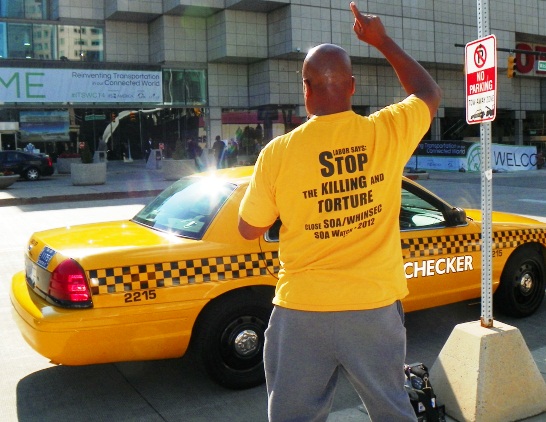
Melvin Thompson shouts at conference attendees, “One world, one workforce.” His T-shirt refers to the School of the Americas, where the U.S. trains torturers and assassins to terrorize workers globally.


